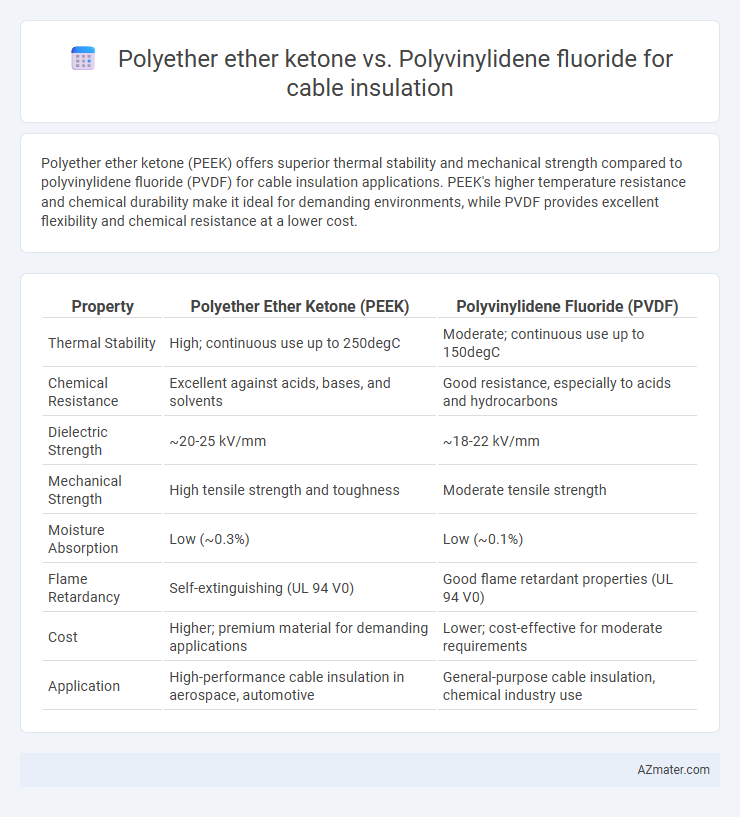Polyether ether ketone (PEEK) offers superior thermal stability and mechanical strength compared to polyvinylidene fluoride (PVDF) for cable insulation applications. PEEK's higher temperature resistance and chemical durability make it ideal for demanding environments, while PVDF provides excellent flexibility and chemical resistance at a lower cost.
Table of Comparison
| Property | Polyether Ether Ketone (PEEK) | Polyvinylidene Fluoride (PVDF) |
|---|---|---|
| Thermal Stability | High; continuous use up to 250degC | Moderate; continuous use up to 150degC |
| Chemical Resistance | Excellent against acids, bases, and solvents | Good resistance, especially to acids and hydrocarbons |
| Dielectric Strength | ~20-25 kV/mm | ~18-22 kV/mm |
| Mechanical Strength | High tensile strength and toughness | Moderate tensile strength |
| Moisture Absorption | Low (~0.3%) | Low (~0.1%) |
| Flame Retardancy | Self-extinguishing (UL 94 V0) | Good flame retardant properties (UL 94 V0) |
| Cost | Higher; premium material for demanding applications | Lower; cost-effective for moderate requirements |
| Application | High-performance cable insulation in aerospace, automotive | General-purpose cable insulation, chemical industry use |
Introduction to High-Performance Cable Insulation Materials
Polyether ether ketone (PEEK) and polyvinylidene fluoride (PVDF) are two high-performance polymers extensively used in cable insulation for demanding applications. PEEK offers exceptional thermal stability up to 250degC, excellent chemical resistance, and mechanical strength, making it suitable for aerospace and industrial environments. PVDF provides superior UV resistance, good flame retardancy, and strong dielectric properties, often preferred in outdoor and harsh chemical exposure scenarios.
Overview of Polyether Ether Ketone (PEEK)
Polyether ether ketone (PEEK) is a high-performance thermoplastic polymer known for its exceptional mechanical strength, thermal stability up to 480degF (250degC), and excellent chemical resistance, making it ideal for demanding cable insulation applications. It offers superior dielectric properties with low dielectric constant and dissipation factor, ensuring reliable signal integrity and minimal energy loss in high-frequency cables. PEEK's resistance to radiation and hydrolysis further enhances its durability in harsh environments compared to polyvinylidene fluoride (PVDF), which, although chemically resistant, typically exhibits lower thermal limits and mechanical strength.
Overview of Polyvinylidene Fluoride (PVDF)
Polyvinylidene fluoride (PVDF) is a high-performance fluoropolymer known for its excellent chemical resistance, mechanical strength, and thermal stability, making it ideal for cable insulation in harsh environments. It offers superior UV resistance and low permeability to gases and liquids compared to Polyether ether ketone (PEEK), enhancing the longevity and reliability of insulated cables. PVDF's inherent flame retardancy and electrical insulation properties ensure safety and efficiency in demanding industrial and aerospace applications.
Mechanical Strength: PEEK vs PVDF
Polyether ether ketone (PEEK) exhibits superior mechanical strength compared to polyvinylidene fluoride (PVDF), making it more suitable for demanding cable insulation applications requiring high tensile strength and impact resistance. PEEK's high modulus of elasticity and excellent wear resistance ensure long-term durability under mechanical stress, whereas PVDF offers moderate mechanical properties but excels in chemical resistance and flexibility. The enhanced structural robustness of PEEK supports reliable performance in harsh environments where mechanical integrity is critical.
Thermal Stability and Temperature Resistance
Polyether ether ketone (PEEK) offers superior thermal stability compared to polyvinylidene fluoride (PVDF), with a continuous service temperature up to 250degC, making it ideal for high-temperature cable insulation applications. PVDF, while maintaining good thermal properties, typically withstands temperatures up to 150degC, limiting its performance in extreme thermal environments. The higher melting point and thermal degradation temperature of PEEK ensure enhanced durability and reliability for cables exposed to elevated temperatures over prolonged periods.
Chemical Resistance and Environmental Durability
Polyether ether ketone (PEEK) offers superior chemical resistance compared to polyvinylidene fluoride (PVDF), effectively withstanding aggressive solvents, acids, and bases commonly encountered in industrial environments. PEEK's enhanced environmental durability includes exceptional thermal stability up to 250degC and resistance to UV radiation and hydrolysis, ensuring long-term integrity for cable insulation. PVDF provides good chemical resistance and weatherability but degrades faster than PEEK under extreme thermal or chemical stress, making PEEK the optimal choice for high-performance, demanding applications.
Electrical Insulation Properties Compared
Polyether ether ketone (PEEK) exhibits superior electrical insulation properties compared to polyvinylidene fluoride (PVDF), with a higher dielectric strength typically around 200 kV/mm versus PVDF's 50-70 kV/mm, enabling better performance in high-voltage cable insulation. PEEK offers lower dielectric constant and loss tangent values, enhancing signal integrity and reducing energy dissipation in electrical applications. Its thermal stability up to 250degC further ensures reliable insulation under extreme operational conditions, outperforming PVDF which generally withstands temperatures up to 150degC.
Flexibility and Cable Design Implications
Polyether ether ketone (PEEK) offers superior flexibility compared to polyvinylidene fluoride (PVDF), enabling more compact and intricate cable designs due to its high elongation at break and excellent fatigue resistance. PEEK's enhanced flexibility reduces mechanical stress on conductors, which is critical for dynamic cable applications requiring repeated bending or flexing. Consequently, PEEK insulation supports innovative cable architectures with tighter bending radii and longer service life, whereas PVDF's comparatively lower flexibility may restrict design options and performance in flexible cable implementations.
Cost-Effectiveness and Availability
Polyether ether ketone (PEEK) offers superior thermal stability and chemical resistance compared to polyvinylidene fluoride (PVDF), but it comes at a significantly higher cost, limiting its use in budget-sensitive cable insulation applications. PVDF is more cost-effective and widely available, making it the preferred choice for standard cable insulation where high-end performance is not critical. The broader market presence of PVDF ensures easier procurement and lower price volatility compared to the relatively niche market for PEEK materials.
Industry Applications and Selection Guidelines
Polyether ether ketone (PEEK) offers exceptional thermal stability, chemical resistance, and mechanical strength, making it ideal for high-performance cable insulation in aerospace, medical devices, and semiconductor industries. Polyvinylidene fluoride (PVDF) provides excellent electrical properties, UV resistance, and flexibility, supporting applications in chemical processing plants, power generation, and wire harnesses for automotive. Selection guidelines emphasize PEEK for environments requiring continuous high-temperature resistance and mechanical durability, while PVDF is preferred where cost efficiency and moderate exposure to harsh chemicals and UV radiation are priorities.

Infographic: Polyether ether ketone vs Polyvinylidene fluoride for Cable Insulation
 azmater.com
azmater.com